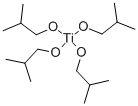Isobutyl hexanoate
Synonym(s):Isobutyl caproate
- CAS NO.:105-79-3
- Empirical Formula: C10H20O2
- Molecular Weight: 172.26
- MDL number: MFCD00048870
- EINECS: 203-332-6
- SAFETY DATA SHEET (SDS)
- Update Date: 2025-12-17 09:50:42

What is Isobutyl hexanoate?
Description
Isobutyl hexanoate has a fruity odor with a cocoa-like undertone. May be synthesized by direct esterifiication.
Chemical properties
Isobutyl hexanoate is a colorless liquid. Almost insoluble in water, soluble in alcohol and oils. Sp.Gr. 0.86. Apple, fruity odor with cocoa-like underto
Occurrence
Reported found in banana, grapes, apple, apricot, beer, rum, cognac, malt whiskey, cider, sherry, grape wines, passion fruit, apple brandy, plum wine, quince, sea buckthorn (Hippophae rhamnoides L.), spineless monkey orange and Chinese quince peel
The Uses of Isobutyl hexanoate
Isobutyl hexanoate is used extensively in flavor compositions, primarily in imitation Pineapple, but also in Apple, Grape and other fruity types. It is occasionally used for special effects in Oriental fragrances, mainly as a modifier in the fruity complex and topnote. The concentration of this ester in the finished consumer product will normally be about 8 ppm.
Definition
ChEBI: A hexanoate ester resulting from the formal condensation of hexanoic acid (caproic acid) with isobutanol.
Preparation
By direct esterification of heptanoic acid with isobutyl alcohol or by treating heptanoic acid and isobutyl alcohol in the presence of defatted Chelidonium majus seeds at 20°C for 3 days.
Aroma threshold values
Aroma characteristics at 2.0%: sweet, estry, fruity pineapple, green apple, peach and tropica
Taste threshold values
Taste characteristics at 10 ppm: fruity, sweet, pineapple, green, tropical and estry.
General Description
A liquid. Flash point 198°F. Insoluble in water and less dense than water. Contact may irritate skin, eyes and mucous membranes. May be toxic by ingestion, inhalation or skin absorption. Used to make other chemicals.
Air & Water Reactions
Insoluble in water.
Reactivity Profile
ISOBUTYL CAPROATE is an ester. Esters react with acids to liberate heat along with alcohols and acids. Strong oxidizing acids may cause a vigorous reaction that is sufficiently exothermic to ignite the reaction products. Heat is also generated by the interaction of esters with caustic solutions. Flammable hydrogen is generated by mixing esters with alkali metals and hydrides.
Health Hazard
Inhalation or contact with material may irritate or burn skin and eyes. Fire may produce irritating, corrosive and/or toxic gases. Vapors may cause dizziness or suffocation. Runoff from fire control or dilution water may cause pollution.
Biochem/physiol Actions
Taste at 10 ppm
Properties of Isobutyl hexanoate
| Melting point: | -64.3°C (estimate) |
| Boiling point: | 348-350 °C (lit.) |
| Density | 0.856 g/mL at 25 °C (lit.) |
| refractive index | n |
| FEMA | 2202 | ISOBUTYL HEXANOATE |
| Flash point: | 169 °F |
| storage temp. | 2-8°C |
| form | clear liquid |
| color | Colorless to Almost colorless |
| Odor | at 100.00 %. fruity pineapple green apple skin green apple sour tropical peach earthy |
| JECFA Number | 166 |
| CAS DataBase Reference | 105-79-3(CAS DataBase Reference) |
| NIST Chemistry Reference | Hexanoic acid, 2-methylpropyl ester(105-79-3) |
| EPA Substance Registry System | Hexanoic acid, 2-methylpropyl ester (105-79-3) |
Safety information for Isobutyl hexanoate
| Signal word | Warning |
| Pictogram(s) |
 Exclamation Mark Irritant GHS07 |
| GHS Hazard Statements |
H315:Skin corrosion/irritation H319:Serious eye damage/eye irritation |
| Precautionary Statement Codes |
P264:Wash hands thoroughly after handling. P264:Wash skin thouroughly after handling. P280:Wear protective gloves/protective clothing/eye protection/face protection. P302+P352:IF ON SKIN: wash with plenty of soap and water. P305+P351+P338:IF IN EYES: Rinse cautiously with water for several minutes. Remove contact lenses, if present and easy to do. Continuerinsing. P332+P313:IF SKIN irritation occurs: Get medical advice/attention. P337+P313:IF eye irritation persists: Get medical advice/attention. |
Computed Descriptors for Isobutyl hexanoate
New Products
Indole Methyl Resin tert-butyl 9-methoxy-3-azaspiro[5.5]undecane-3-carboxylate Boc-His(Boc)-OH 2-CTC Resin 4-Chloro-7-tosy1-7Hpyrrolo[2,3-d]pyrimidine 5,7-Dibromo-1H-indole 2,5-dichloro-N-hydroxy-4,6-dimethylpyridine-3-carboximidamide 2,2-Dimethoxy-7-azaspiro[3.5]nonane hydrochloride 4-chloromethyl-5-methyl-1,3-dioxol-2-one (DMDO-Cl) R-2-BENZYLOXY PROPIONIC ACID 1,1’-CARBONYLDIIMIDAZOLE 1,1’-CARBONYLDI (1,2-4 TRIAZOLE) N-METHYL INDAZOLE-3-CARBOXYLIC ACID 4-((2-hydroxyethyl)thio)benzoic acid 1-(TERT-BUTOXYCARBONYL)-2-PYRROLIDINONE Methyl 6-methylnicotinate 3-Pyridineacrylic acid tert-Butyl carbazate TETRAHYDRO-2H-PYRAN-3-OL 2-((4-morpholinophenylamino) (methylthio) methylene) malononitrile 3-(4-morpholinophenylamino)-5-amino-1H-pyrazole-4-carbonitrile 2,4-dihydroxybenzaldehyde 1,3-Diethyl-1,3-Diphenylurea Methyl 2-methylquinoline-6-carboxylateRelated products of tetrahydrofuran








You may like
-
 Isobutyl Hexanoate CAS 105-79-3View Details
Isobutyl Hexanoate CAS 105-79-3View Details
105-79-3 -
 Pyridine 99.5% HPLC /UV SpectroscopyView Details
Pyridine 99.5% HPLC /UV SpectroscopyView Details
110-86-1 -
 Guanine , 99%View Details
Guanine , 99%View Details
73-40-5 -
 Piperazine Spot supply, best priceView Details
Piperazine Spot supply, best priceView Details
110-85-0 -
 Dibutyl PhthalateView Details
Dibutyl PhthalateView Details
84-74-2 -
 Imidazole Spot supply, competitive priceView Details
Imidazole Spot supply, competitive priceView Details
288-32-4 -
 Octadecyl 3-(3,5-di-tert-butyl-4-hydroxyphenyl)propionate 98% (GC)View Details
Octadecyl 3-(3,5-di-tert-butyl-4-hydroxyphenyl)propionate 98% (GC)View Details
2082-79-3 -
 Thiourea 99% ARView Details
Thiourea 99% ARView Details
62-56-6
